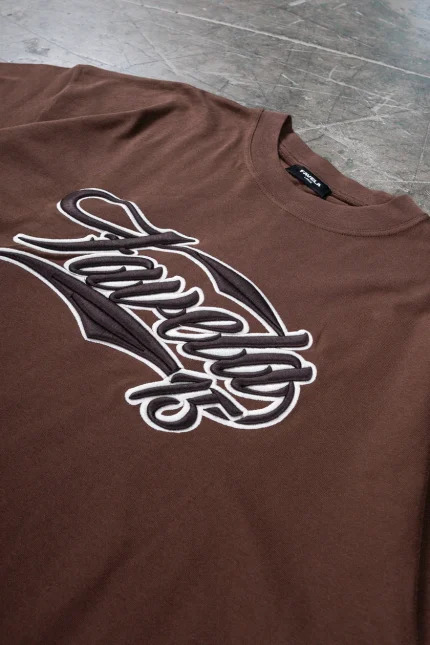In the global fashion landscape, trends come and go like the tides. But some garments transcend the transient nature of style, rising above mere clothing to become potent symbols of identity, resistance, and creativity. The Favela Hoodie is one such garment. Rooted deeply in the urban realities of Brazil’s favelas—informal settlements teeming with life, culture, and complexity—the hoodie has evolved from utilitarian streetwear into a statement piece embraced by fashionistas, musicians, and cultural tastemakers around the world.
This is not just about a hoodie. It’s about how clothing can reflect socioeconomic realities, influence global fashion, and challenge preconceptions. The Favela Hoodie is the product of an underrepresented community turning adversity into innovation and grit into glamour. In this article, we dive deep into the story of the Favela Hoodie, exploring its origins, cultural resonance, and burgeoning influence in international streetwear.
From the Hills of Rio to the Halls of Fashion
The term “favela” refers to the informal neighborhoods that sprung up in Brazil, particularly in Rio de Janeiro and São Paulo, in the late 19th and 20th centuries. Often under-resourced and marginalized, these communities have long been stigmatized in Brazilian society. Yet, within them, a vibrant cultural pulse has always thrived—one that blends music, dance, art, and fashion into a unique expression of life and resistance.
The Favela Hoodie draws its essence from this cultural fabric. Originally, it served a purely functional purpose: to shield young people from the elements as they navigated the narrow alleyways, climbed the steep hills, or hung out in local skate parks and football pitches. The hoodie was accessible, affordable, and comfortable—qualities that made it a staple in every closet across these communities.
But as favela culture began to influence Brazilian music and arts, particularly through genres like funk carioca, hip-hop, and samba, the style of these neighborhoods started gaining wider attention. Local artists and influencers began wearing hoodies not just as comfort wear, but as symbols of pride, resilience, and defiance against societal prejudice. The garment took on new meaning, morphing into what we now recognize as the Favela Hoodie—an emblem of street-smart fashion and cultural authenticity.
Design Language: Raw Aesthetics Meets Artistic Identity
What sets the Favela Hoodie apart from other streetwear pieces is its distinct visual identity. There is an intentional rawness to the design—an embrace of imperfection, asymmetry, and eclecticism. Many versions of the hoodie incorporate graffiti-style fonts, patchwork patterns, or hand-stitched detailing that tells a story. These aren’t mass-produced pieces churned out by faceless corporations; they’re crafted with care, often by local designers who live in the very favelas the hoodie represents.
The design often juxtaposes bold colors with muted undertones—think deep charcoal paired with electric yellow, or earthy browns contrasted with vivid reds. There’s also a unique use of typography and symbols, drawing from Afro-Brazilian iconography, protest slogans, and religious imagery. These elements converge to create hoodies that feel alive, breathing the energy of the streets into high fashion.
Even the choice of materials reflects a deliberate ethos. Eco-conscious fabrics and repurposed materials are increasingly used, aligning the garment with sustainable fashion trends. The imperfections—whether a frayed seam or a mismatched color patch—are not flaws but badges of authenticity. Each Favela Hoodie becomes a one-of-a-kind piece, resonating with the individuality of its wearer.
Social Commentary Woven in Fabric
To wear a Favela Hoodie is to make a statement—whether consciously or not. It challenges long-standing stereotypes about poverty, crime, and marginalization. For decades, the word “favela” was used pejoratively, associated with violence and deprivation. The hoodie turns that stigma on its head, reframing the narrative through the lens of creativity, resilience, and style.
This transformation has not happened in a vacuum. Numerous grassroots fashion initiatives and social enterprises have played pivotal roles in changing perceptions. Organizations like “AfroReggae” and “Nós por Nós” have provided platforms for favela-based artists and designers to showcase their work to a global audience. Some of these collectives even reinvest a portion of profits into community programs, offering workshops on design, entrepreneurship, and digital literacy.
The Favela Hoodie thus becomes a vehicle for empowerment, not exploitation. It’s not about appropriating urban grit for aesthetic clout, but about uplifting the very people who live that reality. Every stitch is infused with purpose; every sale contributes to a larger movement of economic and cultural liberation.
Globalization and the Streetwear Renaissance
Streetwear has seen an extraordinary transformation over the past two decades. Once the exclusive domain of skaters and rappers, it’s now a multi-billion dollar industry, driving collaborations between luxury fashion houses and underground designers. Brands like Supreme, Off-White, and Palace have made hoodies into high-ticket fashion statements, blending comfort with clout.
In this context, the Favela Hoodie finds fertile ground. As consumers seek authenticity and uniqueness, the hoodie’s story-rich origins stand out amidst a sea of generic designs. International celebrities, from musicians to footballers, have been spotted wearing Favela Hoodies, often custom-made by Brazilian designers. This visibility not only boosts the brand but also opens up dialogue about the realities of life in favelas—offering nuance in place of stereotype.
Furthermore, the internet has allowed favela-based designers to reach global markets without traditional gatekeepers. Through Instagram, TikTok, and e-commerce platforms like Etsy or Brazil’s own Enjoei, these artists showcase their collections and sell directly to fashion enthusiasts around the world. This democratization of fashion has given the Favela Hoodie an international stage.
More Than a Trend: The Emotional Appeal
Why are people gravitating towards the Favela Hoodie? Beyond aesthetics and social statements, there’s a raw emotionality to the garment that resonates. It speaks to the universal desire to be seen, to have one’s story told and valued. For someone who grew up in a marginalized neighborhood—whether in São Paulo, Soweto, or the South Side of Chicago—the Favela Hoodie feels personal. It’s a tribute to struggle, triumph, and the communities that raise us.
Even for those outside that lived experience, the hoodie acts as a bridge—an opportunity to connect, learn, and respect a culture different from their own. There’s something profoundly human about wearing a piece of clothing that carries such depth of meaning. It evokes empathy, curiosity, and a sense of global citizenship.
Fashion, at its best, does not merely clothe the body but ignites the soul. The Favela Hoodie accomplishes this beautifully, wrapping its wearer in fabric and story alike.
Challenges and the Future of Favela Fashion
Of course, the growing popularity of the Favela Hoodie isn’t without complications. As demand rises, so does the risk of cultural appropriation and exploitation. There’s a fine line between appreciation and commodification, and it’s crucial that fashion brands tread this line with care and integrity.
For the movement to remain authentic, it must continue to center voices from within the favela. Large fashion houses collaborating with favela designers must ensure fair pay, creative credit, and transparency. The last thing the community needs is to see its culture stripped for profit without receiving due benefit.
That said, the future looks promising. With an increasing emphasis on ethical fashion, consumers are becoming more mindful of where and how their clothes are made. Favela-based labels that operate on fair-trade principles, use eco-friendly materials, and reinvest in their communities are poised to thrive. Moreover, educational initiatives aimed at equipping young designers with digital skills, marketing know-how, and global networks will help solidify the industry for generations to come.
Styling the Favela Hoodie: Urban Couture with an Edge
The Favela Hoodie is remarkably versatile, making it a standout piece for fashion-forward individuals looking to make an impact. Whether paired with ripped jeans, cargo pants, or even a pleated skirt for a contrast-rich ensemble, the hoodie holds its own. Accessories like gold chains, bucket hats, or combat boots elevate the look while remaining grounded in street culture.
High-end stylists have begun incorporating the Favela Hoodie into editorials, layering it under oversized coats or pairing it with tailored trousers for a juxtaposition that blurs the line between street and chic. The hoodie’s adaptability ensures that it can move seamlessly from the skate park to the runway, from the favelas to Fifth Avenue.
And that, perhaps, is its greatest strength—it defies categorization. The Favela Hoodie doesn’t belong to just one world. It is, inherently, a fusion of many: the gritty and the glamorous, the local and the global, the past and the future.
Final Thoughts: A Movement Wrapped in Cotton
At its core, the Favela Hoodie is more than fabric—it’s a form of storytelling, a political statement, a cultural celebration, and a vision for what fashion can be. It represents a radical shift in how we define luxury, creativity, and value in clothing. Rather than chasing after sterile perfection, the Favela Hoodie honors humanity in all its messy brilliance.
In wearing one, you’re not just making a style choice. You’re participating in a movement—one stitched together by resilience, fueled by creativity, and driven by a desire for justice and beauty.
As the world increasingly turns to grassroots innovation and cultural authenticity, the Favela Hoodie stands poised not just as a trend, but as a transformative force in fashion. And if you look closely at its seams, you’ll see the dreams of an entire community woven right in.

